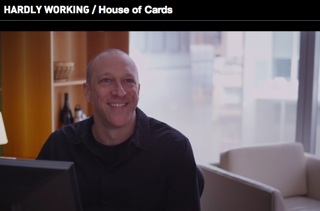A rabbi, a priest, and a content marketer walk into a bar…. Bet you want to know what happens next, right? Well, patience, Vine-brain–you’ll just have to wait until I’m good and ready. Before then, I must establish why CollegeHumor may be the best source for lessons on content marketing in the known universe–lessons I gleaned from a recent interview with their CEO, Paul Greenberg. (Author’s note–this article first appeared several months ago on FastCompany.com and is more relevant than ever even though Greenberg has since moved on.)
Greenberg took over as CEO in 2011 and since then CollegeHumor, a division of IAC, has laughed its way to the bank as site traffic has jumped to 15 million unique visitors per month and annual traffic was up 40% in 2011 and 20% in 2012. With over 4.5 million subscribers, CollegeHumor is also a top-ranked YouTube channel. Along with the 100 million monthly video streams, CollegeHumor fans also devour a smorgasbord of non-video content like comics, articles, and even a feature film,Coffee Town, that’s coming out next month.
So yes, there’s some funny business going on over at CollegeHumor. Their videos seem to go “viral” more often than bunnies make bunnies. Their 1 million Facebook fans are maybe the only happy army in the world, sharing silliness with serious consistency. Okay, with their bona fides established, here are the 18 things CollegeHumor can teach you about content marketing (and 1 they won’t).
1. Start With Talented People
Before you say, “Duh, Drew, I hope the other 17 aren’t so obvious,” let me just remind you that most marketer-created content is unadulterated dreck and the good stuff is more rare than an amusing mortician. Great content starts with great writers. Period. Explains Greenberg: “We have a phenomenal team of very creative people who are very good at what they do.”
2. Get Out of the Way
With content marketing becoming an increasingly important part of the mix, it might be natural to involve senior management. Not so fast, bored-room-breath–if the CEO of a company that is in the business of creating content stays out of it, then perhaps you should, too. Reports Greenberg, “I don’t see any need to micromanage the content team–I just get obstacles out of their way and let them do what they do.”
3. Don’t Start at the Bottom Line
Long before he became CEO at CollegeHumor, Greenberg had firsthand experience as on-air talent (radio announcer, voice-over artist) and with production at MTV Networks. He believes these experiences set up him up for success in his current role, adding, “If there is someone who has never been a creative before and never been on the talent side, you’re going to make decisions purely based on the bottom line–and probably the wrong ones.”
4. Foster a Fear-Free Zone
Even with a talented team, not every piece of content will be a huge hit and some might even bomb. Greenberg admits that even CollegeHumor only expects two or three of the 50 videos a month they produce to generate multimillion views. “You can’t be afraid to fail; you have to be willing to put yourself out there every day with something new,” he advises.
5. Crank It Out
While you need not create as much content as CollegeHumor unless you, too, are only in the content business, you still will need to produce a lot more than one (albeit scintillating) blog post per week. Reports Greenberg, “We’ve got [a video] that comes out every single day and sometimes more than once a day.” Even B2B brands will want to publish a steady stream of quality content, especially as your audience grows.
6. Muster All the Mediums
In addition to creating lots and lots of content for your primary channel, whether that be a blog or YouTube or whatever, you are well advised to be wherever else your customers and prospects might consume your stuff. “We actually do a fair amount of articles, comics, and funny pictures that drive 30% of our traffic, which adds up to three to four original non-video pieces a day,” says Greenberg. “We have a well-oiled machine that is constantly making sure that we’re getting our tentacles out everywhere,” he adds.
7. Master All the Mediums
Even though you’re now thinking broadly about your channel options, don’t think you can simply make hay by putting the same stuff on each platform. Greenberg has a separate production and writing staff for the articles like “8 New Punctuation Marks We Desperately Need,” an article that got over a million views, “because it just got shared everywhere.”
8. Plan On Having a Penurious Plan
Knowing all the channels and types of content you’ll be creating gets you a few steps closer to having a content marketing plan. CollegeHumor plans out their content on a monthly basis and from one production budget. Greenberg tells his staff, “Here’s your pot for the month; some of you are going to spend more on some and less on others, and you know what you have to do.”
9. Seek Out Your Series
I may be going out on limb here, but chances are you aren’t rebranding your company or product every week. Then why the heck are you creating content pieces that are essentially one-offs? Says Greenberg: “We try to be consistent and let people know when things are coming out–that’s the best way to build an audience.” Creating a series of videos or articles will also increase the odds of building up a fan base over the long term. “People will discover ‘Very Mary-Kate‘ on its tenth episode and go back and watch all of them,” he notes.
10. Show Some Patience, Young Lucas
As they say up in Alaska, “Nome wasn’t built a day.” Accordingly, even if you are lucky enough to land on a great idea for a content series and go on to produce fabulous segments, don’t expect the whole thing to be an overnight sensation. “With the series you are less apt to get into [a topical] zeitgeist really quickly, so you’ll build an audience over time,” Greenberg cautions. “They’re not all going to be gems, but you get enough hits so that people start to realize, ‘Wow, these guys have something interesting going on,’” he adds.
11. Listen Like You Have Two Ears and One Funny Bone
Once your content is flo-ing like Progressive’s spokesperson, it’s more than an insurance policy to listen to your audience. By way of example, Greenberg tells the story of CollegeHumor’s live-action “Dora the Explorer” parody that started out as a movie trailer. “The Dora trailer was an enormous hit and our fans wished this was a real movie… so we made a 12-minute movie in three installments,” he explains.
12. Plan for the Unplannable
As they say in the latrine business, “Humor happens,” and when it does, CollegeHumor is prepared to squeeze it for all its worth. Greenberg points to “Gay Men Will Marry Your Girlfriends,” which they released right after Election Day. “It went crazy because it hit a nerve–it was really topical and it was well done,” he recalls. Like CollegeHumor, marketers also need to be prepared to execute quickly when topical opportunities arise.
13. Experiment Elsewhere
Not all content ideas are ready for prime time, so it’s a good idea for brands to have a safe haven to experiment. CollegeHumor accomplishes this by having a microsite called Hardly Working. “It’s a sort-of playground for us, so that’s where we put these weird ideas in motion,” notes Greenberg. Brands can accomplish the same thing by sharing content ideas with a carefully picked customer advisory group or via an employee-only intranet.
14. Support It in Social
Obvious O’Brien here just wants to remind you that once you’ve created your splendiferous content, don’t forget to share it on your social channels and monitor those channels accordingly. Greenberg has one manager “who spends all her time on social networks, is completely in the loop on what’s happening, and [also] pushes stuff to our PR partners.”
15. Dive Into the Data
If there’s something funny about your data, it’s probably not a good thing unless, of course, you work at CollegeHumor. “We have a lot of data [and] we spend a lot of time analyzing it,” declares Greenberg. “We’ll look at the ratio between likes and views: Is this getting shared a lot but not watched a lot?” This data also helps determine if a new piece of content should be serialized or given an extra boost (see next point).
16. Be Prepared to Push
If you take but one thing away from this article, let it be this: Viral doesn’t just happen. Even the best content needs a catalyst–a spark, if you will–to start the fire that, swears the arsonist, just happened. Admits Greenberg, “Once [a video] gets to the half a million level, we start to really pay attention and ask, ‘Do we need to give it a little push somewhere?’” Such a boost could be featuring it on the homepage again or reposting it on their various social media channels.
17. Lighten Up, People
If your content falls in the forest and nobody reads it, even your mother won’t care. Content marketing only works when your target wants to consume it and share it, which is why a touch of levity can turn your dry opus into liquid gold. This doesn’t mean you need to start hiring class clowns and making videos about college kids puking, but it wouldn’t hurt if your writers knew the difference between a punch line and punch bowl.
18. Short Is Sweet
Now it’s go time. You’ve got a plan, a channel or six, social media on standby, a newfound sense of humor and even an epic writer lined up. The only problem now is that your writer penned an epic. Cut. And I mean cut. When it comes to videos, short isn’t just sweet, it’s like being a Doritos salesman when the munchies set in. Confirms Greenberg, “We try to keep [our videos] under 2 or 2½ minutes–anything longer and people really just glaze.”
There you have it–the 18 things CollegeHumor can teach you about content marketing. As for the one thing they won’t… It turns out that they have something called “The SIV” that Greenberg describes as “our secret formula for viral videos that makes sure that certain videos have certain aspects about them.” Bummer he won’t share. As they say over at Electrolux: “It really sucks.”
As for the rabbi, the priest, and the content marketer, you’ll need to bounce over to this other post on TheDrewBlog for the rest of the story. I dare not sully these pages with such inanities. More importantly, you’ll also find my informative interview with Greenberg.

